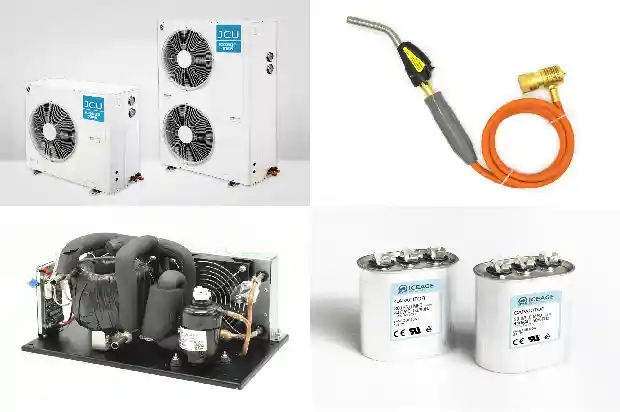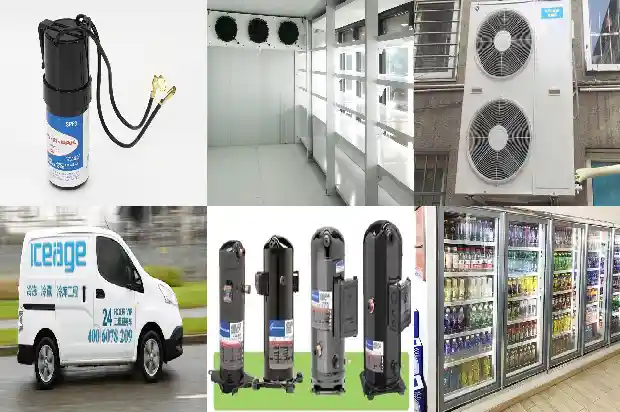Defrosting Operation Modes of Refrigeration Equipment and Its Control Components
2024-09-26
When refrigeration equipment is in operation, the surface of the evaporator coil is prone to frosting. If the frost is too thick, it will affect the refrigeration effect, so defrosting is required in time. Due to different temperature ranges, the corresponding control components for defrosting operation of low-temperature refrigeration equipment and medium-temperature refrigeration equipment are also different. Generally, there are defrosting methods such as shutdown defrosting, defrosting by relying on the heat generated by itself, and defrosting by adding external devices.
For medium-temperature refrigeration equipment, the operating temperature of the evaporator coil is generally lower than the freezing point temperature, while it is higher than the freezing point temperature when shut down. Therefore, the shutdown defrosting method is generally used for medium-temperature refrigeration equipment, such as refrigerated display cabinets. When in operation, the temperature inside the cabinet is about 1°C, and the coil temperature is generally about 10°C lower than that inside the cabinet.

For low-temperature refrigeration equipment, the operating temperature of the evaporator is lower than the freezing point temperature, and regular defrosting must be adopted. When the air temperature inside the freezer is far below the freezing point temperature, heat needs to be provided to the evaporator for defrosting. The heat required for defrosting generally comes from the internal heat in the system and the external heat outside the system.
The defrosting method using internal heat is generally also called hot gas defrosting. It uses hot vapor from the compressor, connects it from the exhaust pipe of the compressor to the inlet of the evaporator, and makes the hot vapor flow fully until all the frost layers on the evaporator are completely melted. Since the energy used for defrosting comes from the system itself, this is an economical and energy-saving method.

If the evaporator is a single pipeline and the expansion valve is a T-shaped pipeline, hot gas can be directly sucked into the evaporator for defrosting. If it is a multi-pipeline, hot gas must be injected between the expansion valve and the refrigerant distributor to make the hot vapor flow evenly into each pipeline of the evaporator to achieve the purpose of balanced defrosting.
Defrosting operation is generally started by a timer. For different equipment or states, the time set by the timer is different to prevent excessive energy consumption or improper food temperature due to excessive defrosting time.
Defrosting termination can be determined according to time or temperature. For temperature termination, a temperature sensing device needs to be set to determine whether the evaporator temperature is higher than the freezing point temperature. If the temperature sensing device detects that the temperature is higher than the freezing point temperature, the hot vapor entering the evaporator should be cut off immediately to restore the system to normal operation. In this case, a mechanical timer is generally installed at the same time, and the defrosting operation is terminated according to the electrical signal of the temperature sensing element. The basic process of the actions of each component is: when the set defrosting temperature is reached, the timer contact is closed, the solenoid valve is opened, the fan stops running, the compressor continues to run, and hot vapor is sent into the evaporator. When the coil temperature rises to a certain value, the temperature controller contact switches, and the X terminal on the timer is disconnected, and defrosting is terminated. When the coil temperature drops to a certain value, the temperature controller contact switches, and the fan restarts.
During hot vapor defrosting operation, the timer needs to simultaneously coordinate the operation of the following components:
- The hot vapor solenoid valve must be opened;
- The evaporator fan stops running, otherwise cold air cannot effectively defrost;
- The compressor must run continuously;
- When the defrost termination switch cannot terminate defrosting, the timer must be set with the maximum allowable defrosting time;
- The drain pipe heater is energized.
Some refrigeration equipment uses external heat sources for defrosting. For example, an electric heating device is installed near the coil. This defrosting method is also controlled by a timer. The defrosting ability comes from an external device, so it is less economical than the hot gas defrosting method. However, if the pipeline distance is longer, the efficiency of electric heating defrosting is relatively higher. When the hot vapor pipeline is longer, the refrigerant is prone to condensation, resulting in a very slow defrosting speed. Even liquid refrigerant may enter the compressor, causing liquid return and damage to the compressor. The electric defrost timer needs to control the operation of the following elements:
- In most cases, the evaporator fan stops running;
- The compressor stops running;
- The electric heater is energized;
- The drain pipe heater is energized.
The temperature sensor used in conjunction with the timer is generally a single-pole double-throw device with three leads, a hot contact and a cold contact. When the coil temperature rises, the hot contact terminal is energized. When the coil temperature drops, the cold contact terminal is energized.
To avoid excessive defrosting duration or compressor overload after defrosting, a defrost termination switch, also called a fan delay switch, can be installed on the system. The temperature sensing bulb of the defrost termination switch is generally set at the upper end of the evaporator. Once all the ice on the coil is melted, the discrete temperature sensing bulb of the defrost termination controller can detect the defrosting heat, close the contacts on the controller, and energize the defrost termination solenoid valve to restore the system to refrigeration. At this time, the evaporator and fan do not start immediately but will start running after a delay to eliminate the heat still remaining on the coil and avoid overload of the compressor due to excessive suction pressure after defrosting. At the same time, it avoids the fan blowing wet air onto the food in the cabinet.
Related Articles
- Essential for Maintenance! Parameters and Phenomena of Normal Operation of Refrigeration and Heating Systems
- What is the Correct Operation Method of the Distribution Box during Cold Storage Installation?
- Operation of Screw - type Water - cooled Chiller Units
- Considerations in Selecting Packaged Air Conditioners and Their Heat Recovery Operations
- Common Malfunctions in the Operation of Cold Storage
- What Are the Three Essential Conditions for the Safe Operation of the Refrigeration System?
- Common Issues in Chiller Operation and Solutions
- Operations and Precautions for Multi - split Air Conditioners: Blowing Debris, Air Tightness, Vacuum Drying, and Refrigerant Charging
- What Should Be Done When the Condenser Fan Doesn't Rotate During Operation?
- Experience Sharing on Refrigeration Welding Operations
- Maintenance and Operation of Freezing and Cold Storage Warehouses
- Cooling Operation of Ammonia Refrigerated Cold Storage
- Water-cooled Screw Chiller: Operation and Maintenance
- Oxyacetylene Welding Operation Method for Refrigeration Pipes
- Startup and Shutdown Operations of Screw Chiller
- What to Do When Power Failure Suddenly Occurs During Cold Storage Operation
- Cold Storage Daily Operation and Maintenance
- Operation Process for Switching On and Off the Chiller Unit
